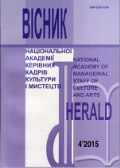GENESIS OF THE UKRAINIAN YOUTH SUBCULTURE
DOI:
https://doi.org/10.32461/2226-3209.4.2015.138426Keywords:
youth subculture, youth associations, youth generation, youthAbstract
The article is dedicated to the analysis of research concepts of formation and development of youth subculture in Ukrainian scientific literature. It was found out that the term "youth subculture" originated in Western science on the verge of social sciences at the beginning of twentieth century.
It was found out that the beginning of investigation of youth subculture as a phenomenon of cultural
differentiation of society is the understanding of the heterogeneity of social and cultural space. Researchers in the field of sociology, cultural studies, psychology, ethnography and other social sciences, are studying the value orientation of ethnic and social groups state their distinctiveness from the socio-cultural community through marginality and deviance of behavior.
It is proved that former USSR and Soviet Ukraine scientists’ research approaches to the problems of youth
subculture substantially differ from foreign scientists’ research of the same period. Thus, the concepts of formation and development of youth subculture are mainly limited to the classification of youth associations and periodization of thehistorical formation of the young generation.
The analysis of periodization of formal and informal youth associations’ development makes it possible to
identify the main directions of youth trends and find out their political choice, to investigate the formation of social and cultural ideas and to analyze the dynamics of patriotic revival among young people.
On the basis of Soviet scientific literature analysis it is found out that scientific interest in youth issues became especially apparent in the social sciences, but was often limited to general problems of the young generation and periodization stages of the young person development. In the former USSR there were ethnic, psychological, spiritual, moral, gender, physical problems of youth, that were able to unite it in a certain subculture. However, at a time when in foreign literature there was a variety of scientific approaches to the analysis of youth issues (anthropological, ethnographic, historical, cultural, sociological, etc.), politicization of Soviet scientific literature prevented multiaspect analysis of youth issues and formulated research ideas in line with the Communist Party. Conflict of generations, which was vividly discussed in the context of foreign philosophical and sociological discourse in Soviet literature was denied by ideologically oriented domestic scientists. Rejecting any contradictions in socialist society, they argued that the conflict of generations is possible only within the class structure of society, and under socialism, the contradictions can have only local conditionality.
It is determined that modern Ukrainian researchers in democratic reforms, publicity and pluralism of the 1980s see the conditions for the emergence of modern formal and informal youth subcultures. It is proved that by the mid-1980s youth subculture appears to be an exponent of social and political attitudes of the young generation, which indicates the presence of a new alternative ideology and the emergence of new value orientations. The need of self-determination, identity, approaching to the global youth community is embodied in the latest trends of youth subculture, forming their own value orientations, spiritual and moral guidance.
It is concluded, that modern foreign and domestic researches on the problems of youth subculture are
characterized by a multiplicity of approaches. If at first the youth were studied within such sciences as, sociology, philosophy, ethnology, and psychology, contemporary researches of the present day would be enriched by various discourses of modern science, based on the meeting-points of many other humanities. Today reasoning and identifying the nature and trends of youth subculture development requires a complex analysis based on a combination of different methodologies.
Downloads
Published
Issue
Section
License
Authors who publish with this journal agree to the following terms:
1. Authors retain copyright and grant the journal right of first publication with the work simultaneously licensed under a Creative Commons Attribution License International CC-BY that allows others to share the work with an acknowledgement of the work's authorship and initial publication in this journal.
2. Authors are able to enter into separate, additional contractual arrangements for the non-exclusive distribution of the journal's published version of the work (e.g., post it to an institutional repository or publish it in a book), with an acknowledgement of its initial publication in this journal.
3. Authors are permitted and encouraged to post their work online (e.g., in institutional repositories or on their website) prior to and during the submission process, as it can lead to productive exchanges, as well as earlier and greater citation of published work (See The Effect of Open Access).


